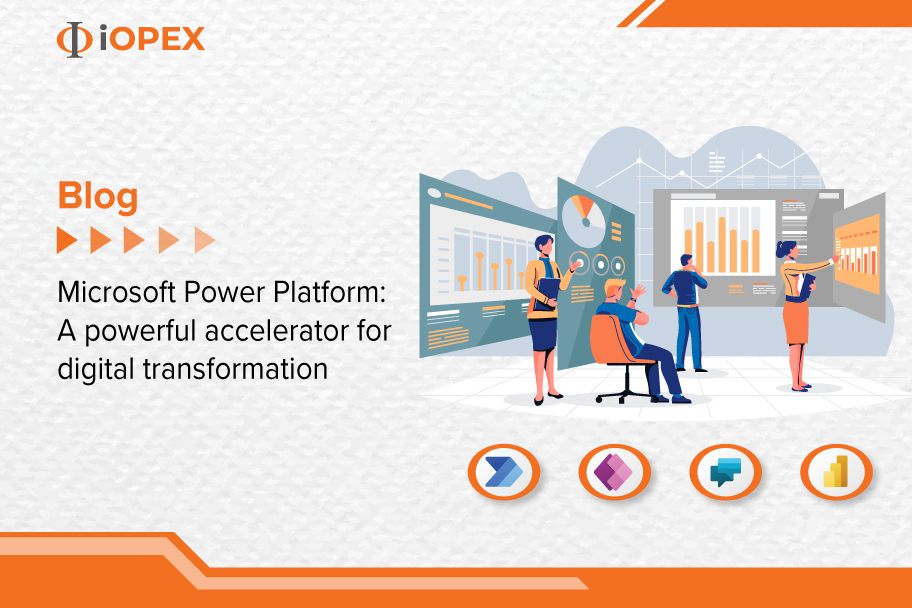There are plenty of excellent platforms and tools available to fuel digital transformation. Increasingly, too, they’re a low-code or no-code solution: a suite of software that can build automation, analytics & applications from the ground up without extensive development skills. These tools level the playing field for businesses that want to automate unique processes, gather data and improve their customer and employee experiences. Microsoft’s Power Platform is emerging to be one of the best.
Power Platform combines low-code application development, workflow automation, AI bot development and data analytics to give organizations a centralized hub to work and integrate business functions. Since it’s developed by Microsoft, it also connects seamlessly and securely with Azure, Dynamics 365 and Microsoft 365 cloud services — operating applications that are already core to many businesses.
So what can you do with Power Platform to really transform how your operations function in the digital world? First, let’s explore why it’s so beneficial for companies to adopt digital workflow solutions.
The benefits of transforming the digital workflow
Ideally, a workflow should comprise interrelated platforms and systems. Each of these is designed to complete its own tasks, yet entwines appropriately with the rest, making it easier to collaborate and share information. To accomplish this, a workflow must not only be automated, but integrated. Process workflow & integration solutions such as ServiceNow or Salesforce bring various business functionalities together — they’re a layer over systems of record, enhancing the processes and bridging data communication gaps.
Microsoft Power Platform, then, can be indispensable to intelligent workflow design and a good alternative that most enterprises are beginning to embrace to build systems of transactions over the systems of records . With it, you can aggregate multiple data silos into a central source of information, streamlining processes and cutting the risk of lost or inaccurate data. Synchronizing users allows them to work more fluidly, reducing the need to switch systems or complete more manual processes. They’ll be more satisfied and productive while customers get a swifter, higher-quality service. And, the more platforms you integrate successfully, the greater those benefits may grow.
We might reasonably call Power Platform a dark horse for workflow integration because Office 365 — its most popular operating platform — is usually reserved for storage or content creation. However, when you add Power Platform on top of Office 365 or Dynamics 365 (bringing finance, commerce and sales management into play, among other abilities) you get a 360-degree view on an improved CSM. Think of Power Platform as the nucleus around which Microsoft and its related products congregate.
Accelerate digital transformation with Power Platform
Essentially, Power Platform comprises of four key products, which their own core functionalities:
- Power Apps: Crafting tailored mobile applications for internal business use.
- Power Automate: Designing automated workflows for a huge range of tasks.
- Power BI: Analyzing swathes of data from various sources.
- Power Virtual Agents: Developing chatbots that are meant to mimic human behavior.
Using rest APIs, logic flows, ready-made automation code and drag-and-drop feature building, each Power Platform component lets you compile and distribute actionable data to inform decisions or develop apps from scratch. They can also integrate for cross-functionality, linking actions and data fields for mutually dependent processes. Connector libraries are readily available to amalgamate Microsoft products and hundreds of other applications. Some of its most useful connectors includes and not limited to:
- Office 365 Outlook.
- Dynamics 365.
- Salesforce.
- Dropbox | OneDrive.
- Adobe Creative Cloud.
- Azure
Let’s take four examples to demonstrate use cases on how Power Platform toolkit can enable collaboration, automation and productivity in an enterprise:
Power Apps
The high-productivity development platform has three main components: canvas apps, model-driven apps, and portals.
Canvas Apps: it allows you to design and build apps with the flexibility to arrange the user experience and interface the way you want it. Start with a blank canvas, then drag and drop elements onto it and create Excel-like expressions for specifying logic and working with data. This app type allows for a high degree of customization connecting over 200+ unique data sources, making them more flexible than model-driven apps. However, canvas apps are not responsive by design, come with two basic layout options and need some coding to create a specific look or feel. Here are a few use cases for canvas apps:
- PTO requests
- Expense entry and approval
- Event registration
- IT help desk ticketing
- Time tracker
- Site inspection
Model-driven apps: They are component-focused and do not require any code. The layout for model-driven apps is already largely designated by the components added in. Data for this app is pulled from Dataverse, and the goal of the app is to drive interaction through complex business logic rather than the interface. They are ideal for mobile use due to the responsiveness of the interface. Some use cases for model-driven apps are here:
- Customer relationships management
- Event management
- Design of business processes and workflows
- Asset tracking system
- An end-to-end solution
Portals: Portals enable users outside an organization to sign in to create and view data, plus the option to view content anonymously without signing in. Portals allow for an end-to-end experience for designers to quickly create a website and customize it with pages, layouts, and content. Few use cases for Portals are:
- File sharing with a client
- Customer service requests
- Sales intake forms
- Event registration and information
Power Automate
The cloud-based tool allows the automation of workflows and processes for businesses, which includes Creation of workflows, Task automation based on recurring, frequent and routine status, Automation of legacy business processes and Logic design for Power Apps. Broadly they are segregated into two categories Flow & UI Flow
Flow is used for workflow automation, it is further listed under three categories;
- Cloud flows
- Business process flows
- Desktop flows
UI Flow comes in handy for legacy software that does not have an API. It essentially smoothens the way for legacy software to exchange data with cloud applications. It enables reproducing the user actions to transform manual tasks into automated workflows by mimicking human drive interaction. it can adopt a machine learning solution to resolve more complex issues.
Few Use cases for Power Automate includes:
- Helpdesk process automation
- Real-time order processing & monitoring
- Billing & claims automation
- Data tracking, document processing & approval workflow
- HR processes automation – staff onboarding & offboarding, payroll, shift rotation and reporting.
- Automation of processes like sales analytics, return orders, new product launch and more
- 24X7 customer query assistance
Power BI
You create customized graphs, charts and timelines from thousands of pieces of consumer data. Revenue, online engagement, product use, renewed contracts, feedback scores — the list of potential insights is endless. Power BI connects to every application or platform that gathers data in your organization. It can then synchronize with Google Sheets and Excel for sharable displays, or embed visuals into any apps you’ve designed. The Dashboard component can be individually accessed or can be plugged into any applications or portals.
Power Virtual Agents
You develop a chat agent to deal with customer enquiries in your retail business. The AI can draw on critical data such as opening times, delivery updates, service commitments and FAQs, solving problems or directing people to further assistance. At the outset, you’re able to build logic flows to imitate a relevant conversation, ensuring useful answers or questions branch off from the customer’s responses.
The benefits of using Power Platform
Since many businesses already use some of the Microsoft suite of programs and applications — such as Office or Dynamics — it’s a logical step to consider Power Platform. This can be an effective way to synergize those systems already in place with a solution from the same developer, ensuring consistency and compatibility.
Beyond that, however, there are many advantages to spurring digital transformation with Power Platform. Here are just several of the benefits your organization can look forward to:
Seamless data integration
Since tools and applications remain connected, you avoid the risk of missing crucial data, duplicating data sets or rendering some information incompatible with other fields and formats. Insights flow across your tech suite, giving diverse users the view and context they require for actionable work. You also have the confidence that any data is refreshed in real time, accounting for the true complexity of the sources you’re tapping into.
Cloud integration
Likewise, Power Platform melds on-premises databases with those in the cloud, broadening accessibility for anyone with a connected device. Cloud storage is more flexible and reliable; often, too, more secure, thanks to encryption and backups. This isn’t useful only for your employees who require consistent access, but partners, clients or contractors who need to use your platform on demand, from anywhere in the world.
Customizable apps
If your business processes change, you don’t have to rebuild an app from scratch to accommodate them. Power Platform makes redesigning apps simple, removing or adding features in minutes. The App Designer offers models with custom page authoring: a toolset for tweaking buttons, boxes, sliders, containers, display forms and other UI elements.
Better metric-based decisions
As well as data gathering, your reports and visualizations are also automated. Therefore, there’s far less effort involved in setting and tracking relevant metrics across different applications and use cases. This strengthens the strategies you’ll pursue for sales, marketing, product development, customer engagement, employee wellbeing or any decisive business activity. Furthermore, Power Platform’s integrations ensure you can share these reports to any key stakeholders, in any way they prefer to access them.
More productive employees
Less time spent searching for data or completing repetitive, mundane tasks means your workers can concentrate on what they’re best at. As the business transforms, they’ll appreciate the freedom that comes with integrated automation. Your bottom line will become healthier as a result.
Lower development costs
Power Platform’s pre-built templates and connectors don’t require highly skilled technical developers — talent that rarely comes cheap. Instead, you’re able to build, launch and iterate custom apps with a fairly basic IT team. Additionally, straightforward app creation prevents more costs being sunk into projects with raw, untested code, which is more susceptible to bugs and security weaknesses.
Find out more about using Power Platform to transform your business operations
Microsoft boasts some of the most generous integrations and capabilities for better business workflows. It is well worth your time. Power Platform could be the single answer you’ve been looking for to supercharge efficiency, collaboration and new opportunities in your target markets. Without it, you may be stuck in the past, steadily overwhelmed by modern data demands, as well as the interrelated tasks your employees increasingly depend on.
At iOPEX, we’re experts in engineering incredible experiences through digital transformation. To find out how we can help you meet your process automation needs with Power Platform, contact our advisors today.











